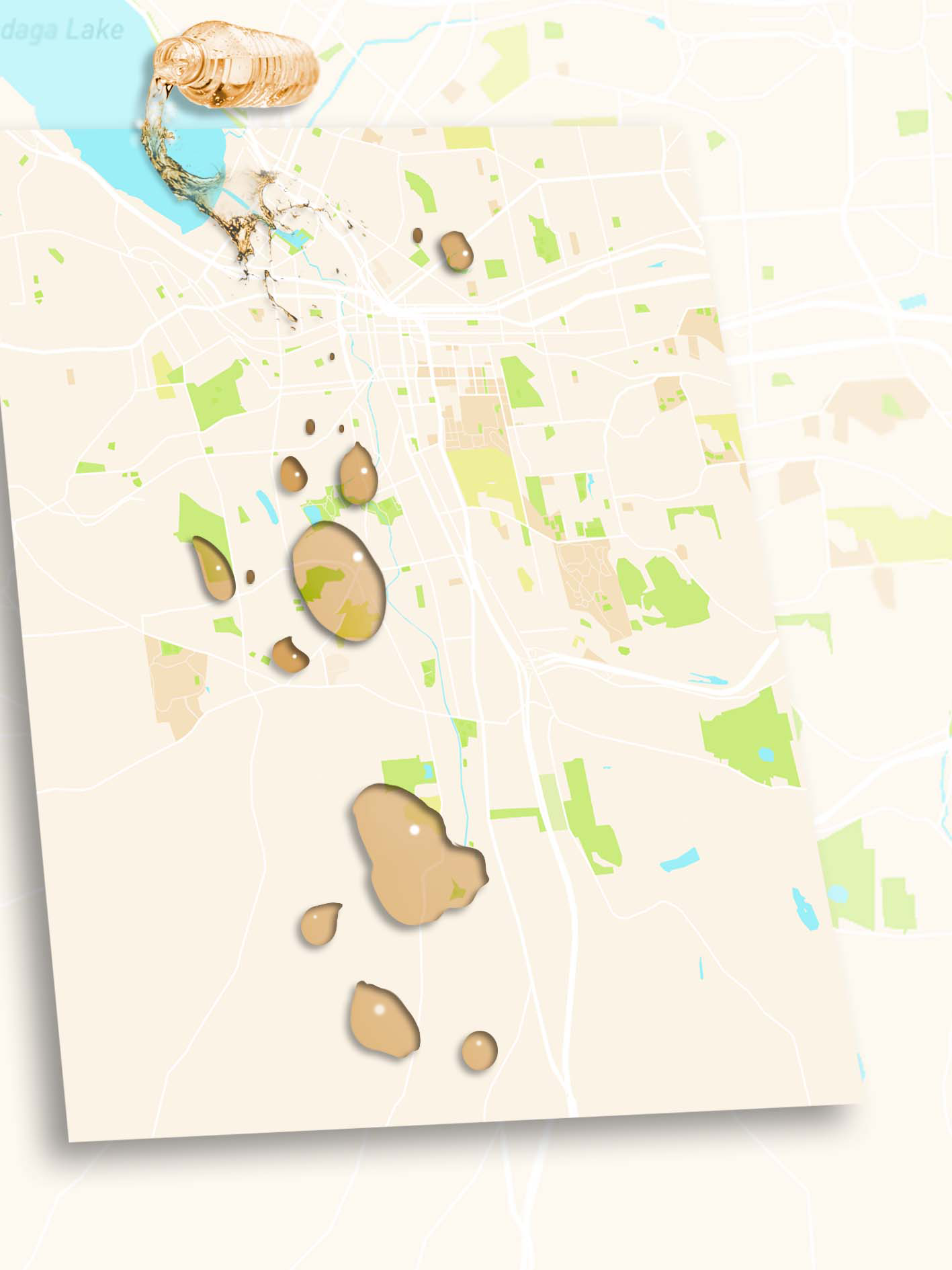
Syracuse, the fifth-largest city in the state of New York, is one of the places that experience a high level of water pollution and associated health issues of the residents. The city’s watershed including Onondaga Lake has been heavily polluted with chemicals including mercury due to household sewage and industrial wastewater since the beginning of the 20th century (Rowell et al., 2015). The water degradation in Onondaga watershed particularly affected the Onondaga Nation Reservation located south of the city of Syracuse where half of the population is Native American. The Onondaga tribe, traditionally relying on Onondaga Lake and waterscape for food sources was significantly affected by sediment runoff as a result of the salt brine mining (Perreault et al. 2012). Silt and sediment accumulation affected the aquatic ecosystem and fish migration, as well as human health with several different pathogenic microorganisms (Huang et al., 2018). Additionally, certain chemicals contained in the water stream such as mercury and other hazardous materials can accumulate in the eutrophic lake, affecting people through the food web and other pathways (Todorova et al., 2009). To eliminate the social injustice within the community, the environmental health disparities and other associated issues in Syracuse must be addressed to ensure the social needs and welfare as well as the equal social opportunity of the local community (Agyeman et al., 2016). The indigenous and native perspectives on land ownership and the environment must be also taken into account (Manno et al., 2013).
I made a story map that will briefly walk you through the story of water pollution and its specific impacts on the Onondaga Nation Reservation. The story map contains several maps and images to help you better understand the environmental disparities present in the Syracuse area. To access the story map, click the link below or the image in the post.
Story Map: https://arcg.is/14CHDX
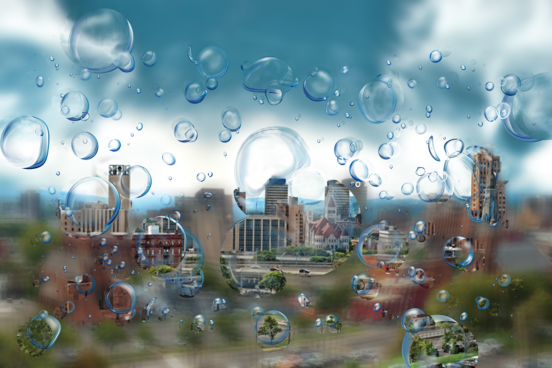
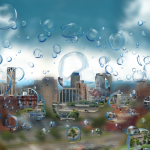

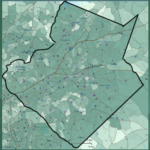
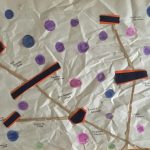
Prof. Michael Heiman (Emeritus)
May 1, 2020 — 4:22 pm
Well-done visual display. Does Syracuse rely on contaminated Onondaga Lake for its water supply? I thought it was Skaneateles Lake. As for the Onondaga Nation in Nedrow south of the city, where does it get its water from? Is it still associated with Onondaga Lake (yes–one of the most polluted water body in the nation)? The lake has historically been sacred for the Onondaga People (scared?). The toxic history of the lake is interesting–well beyond Honeywell’s contribution and tied to the very foundation of Syracuse’s industrialization (with the Solvay Process). The main historic pollutant is mercury which, alas, doesn’t break down but rather combines with organics to form the deadly bioaccumulative toxin, methyl mercury.
Sooik
May 2, 2020 — 12:49 am
Thank you!
That’s a great point! Syracuse does not rely on Onondaga Lake since the lake is way too contaminated. The primary drinking water supply for the residents of Syracuse is Skaneateles Lake which is about 20 miles from the city. Onondaga County including the Reservation receives its drinking water mostly from Skaneateles Lake or Lake Ontario. Thus, there is little risk associated with drinking water. However, through the consumption of fish from the lake, certain people are still exposed to the risk of elevated levels of mercury and other toxic chemicals.
Yes. the industrialization and water pollution in Syracuse and adjacent areas have a long and interesting history since the 19th century. It is really interesting how inorganic mercury is converted into organic methylmercury by bacteria and other microorganisms in the water body. Water pollution and the excess of nutrients in Onondaga Lake also caused the algal blooms and increased amount of microorganisms in the water. It would be interesting to look at the effect of eutrophication on methylmercury synthesis.
Aisha Rodriguez
May 1, 2020 — 5:42 pm
I really enjoyed your visual and the story map! When thinking about injustices that Native American communities face, I always like to discuss/consider how colonialism informs these decisions. Water contamination also serves as an act of violence towards indigenous peoples, as water (and thus food sovereignty) is vital to the sovereignty of indigenous nations. This occurs not only because food and water are vital to nutrition/life, but the foods grown are directly connected to many creation stories – thus there is a strain on both human health and spirituality. You mentioned that in order to address this inequity, action must be taken in both access and opportunity – in what ways can this be done? How do you think this should be addressed? (legally, communally, etc)
Sooik
May 2, 2020 — 1:47 am
Thank you! Yes as you noticed, water absolutely means more than just the source of food and subsistence to many indigenous communities. In many Native tribes, water is related to their tribal sovereignty and also cultural identity. As you mentioned, this also has a lot to do with indigenous creation stories. The Algonquin and Iroquois creation stories particularly involve many animals related to water, showing that water is a sacred entity in this area. To address the issue of water pollution and disparities, there should be more systematic and comprehensive solutions. There has been a clean-up project to eliminate the toxic materials and restore the lake ecosystem for decades. However, the clean-up plan, currently carried out by Honeywell Inc., according to the Onondaga Nation, only covers a small portion of the entire contaminated area. To restore the lake and also alleviate the inequality, the restoration plan must include the participation of the tribal nation and the other affected communities. As making decisions and moving forward with the restoration projects, the state government must also respect and take into consideration the significant meaning of water to the Onondaga and other indigenous people.
Natalie
May 1, 2020 — 5:45 pm
Great job! Remind me why you chose this location? The story map was a great platform on which to display the narrative of the Onondaga nation. I particularly like how you made the image show which way the river flows by using our perception of gravity effecting water droplets on a flat map. Very effective!
Sooik
May 2, 2020 — 1:52 am
Thank you so much! Yes! I spent last summer in Syracuse doing research at the Upstate Medical University, and one of the lab members told me about the lake. I also got to observe a lot of impoverished areas in the city, so I thought it would be interesting to see how water pollution affected those communities.
galbanv
May 1, 2020 — 5:50 pm
Yikes, what a sad story. It reminds me of our classwork regarding the inequalities between people and whose goals are put before others. Clearly, the US government does not consider the welfare, culture, and health of the Native American community to be important. It is very sad to me that the grassroots effort to approach the US Supreme Court failed. Do you think other grassroots efforts might be more successful, or does this situation call for a more global approach?
Sooik
May 2, 2020 — 3:15 am
Absolutely! It is obvious that for more than a century, the U.S. government and private corporates did neglect the needs and welfare of the Onondaga tribe. The state government has tried to clean up the lake through the clean-up plan involving Honeywell, one of the main polluters. While this clean-up plan is not comprehensive and aggressive enough, such clean-up projects on the state level are definitely an efficient way to just restore the lake ecosystem and remove pollutants. The Supreme Court ruling in 2013 was not in favor of the Onondaga Nation. But a series of other cases also ruled that the polluters are obliged to clean up the contaminated lake. I believe what they really need is collaborative efforts that involve every stakeholder including the Onondaga Nation and other communities.
parsonsa
May 1, 2020 — 5:50 pm
Your visuals are very well done! The relationship between the water pollution and Indigenous practices is an unfortunate finding, but it is an important contribution to the project.
RM
May 1, 2020 — 6:08 pm
The story map was a great idea to explain the history and concerns regarding the Onondaga nation and lake. I thought it was very creative and was organized in such a manner that was easy to follow and easy to understand. This is an important finding to promote cultural equality. Water was also a part of my (un)just sustainabilities project and I understand how its so unfortunate when water is contaminated as it effects so many aspects of life. Its especially disheartening when the Native American community lost the lawsuit in the Supreme Court. Very well done!
Kristin
May 1, 2020 — 6:09 pm
Curious about the tribe’s lawsuit – is part of the land bordering the lake? Who “owns” waterways is always an interesting component of water policy. Any information on why the courts ruled against their lawsuit?
Sooik
May 2, 2020 — 8:28 am
Good point! The Onondaga Nation Reservation is not directly bordering the lake. But Onondaga Creek flowing into the lake runs through the tribal land, which is why water pollution has particularly affected them. Originally, the lawsuit was filed by the Onondaga Nation in 2005, to ask for a judgment that New York’s acquisition of indigenous lands in the late 18th and early 19th centuries was not legal. They hoped that the recognition would lead to negotiations with New York State regarding the redress of injustice problems they have experienced, including water pollution and environmental degradation. However, the court dismissed the lawsuit, on the ground that it has been too long since the alleged offense.
brownemm
May 1, 2020 — 6:29 pm
This is such an important issue. Its really interesting to learn about this now and hear about the lawsuit, especially in the context of other native communities’ battles against water pollution in lands they depend on for survival. I wonder if they have partnered with other tribal communities in New York and across the border in Canada to try and fight this issue with a broader group?
Sooik
May 2, 2020 — 10:12 am
That is an interesting point. I don’t think they have so far partnered with any other tribes to address the water pollution issue. But considering that many other tribes have experienced similar injustice issues regarding water and environmental degradation, it is definitely a great idea to partner with other tribes in New York State (such as Oneida Nation) or tribes in Canada around Lake Ontario. Great point!